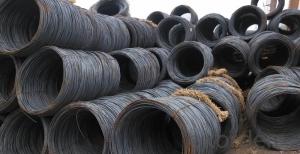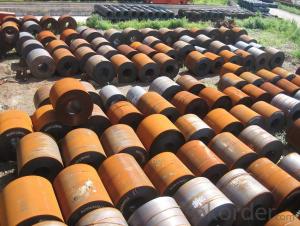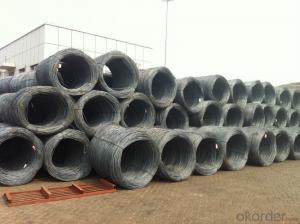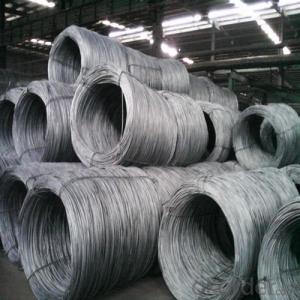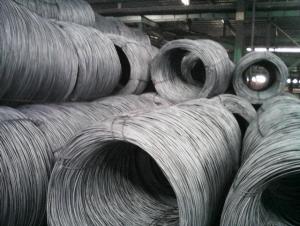SAE1008 Steel Wire Rod
- Loading Port:
- China Main Port
- Payment Terms:
- TT OR LC
- Min Order Qty:
- -
- Supply Capability:
- -
OKorder Service Pledge
OKorder Financial Service
You Might Also Like
Specifications of Wire Rod SAE1008B:
Grade: SAE1008B Standard: ASTM
Diameter: 5.5mm, 6.5mm, 7mm, 8mm
Alloy or Not: Alloy
Technique: Hot Rolled Place of Origin: China Mainland
Chemical Composition:
Please kindly find our chemistry of our material based on SAE1008B as below for your reference:
Grade | Chemical Composition (%) | |||||
C | Mn | S | P | Si | B | |
SAE1008B | 0.10max | 0.32max | 0.045max | 0.040max | 0.30max | 0.0008min |
Mechanical properties | ||||||
Yield strength(N/mm2) | Tensile strength(N/mm2) | Elongation (%) | ||||
≥195 | 350-380 | ≥32 | ||||
Usage and Applications of Wire Rod SAE1008B:
After hot-rolled the products shaped into coil and delivery as finished product, including round, square,rectangular, hexagonal and so on. Since most of the products are round, it is generally called wire rod. Carbon steel wire rod is widely used in construction and manufacturing. Carbon steel wire rod is mainly used for reinforcement of reinforced concrete and welded structure or reprocessed (roberts , nail, etc.) materials, especially used to produce wire drawing, welding electrode, nails, spring, electronic, precise machinery parts and so on.
Packaging & Delivery of Wire Rod SAE1008B:
Packaging Detail: products are packed in coil and then shipped by container or bulk vessel
Each coil weight: About 2.05MT
Delivery Detail: within 45 days after received deposit or LC.
Label: to be specified by customer, generally, each bundle has 1-2 labels
Trade terms: FOB, CFR, CIF
*If you would like to get our price, please inform us the size, standard/material and quantity. Thank you very much for your attention.
- Q: How is steel wire rod used in the manufacturing of wire for shipbuilding applications?
- Steel wire rod is used in the manufacturing of wire for shipbuilding applications as it serves as the primary raw material for producing high-quality wires. This wire rod is first drawn through a series of dies to reduce its diameter and increase its length, resulting in a thinner and longer wire. This wire is then further processed and fabricated into various components such as cables, ropes, and structural elements used in shipbuilding. The strength and durability of steel wire rod make it an ideal material for withstanding the harsh marine environment and ensuring the safety and reliability of ships.
- Q: What are the different surface marking methods for steel wire rod?
- Steel wire rods can be marked using various surface marking methods, each serving the purpose of identifying and providing information about the wire rod. One commonly used method involves hot stamping, which impresses an identification mark onto the surface of the wire rod using a heated stamp. This method is reliable and long-lasting since the mark becomes permanently engraved on the steel's surface. Another technique, inkjet printing, involves using an inkjet printer to directly print the necessary information onto the steel wire rod. This method is speedy and allows for flexibility in marking different types of information. Laser marking is also a popular choice, where a laser beam is utilized to remove or alter the surface material of the wire rod, leaving a permanent mark. This method offers precise and detailed markings. Moreover, embossing or engraving can be utilized to create raised or indented markings on the wire rod's surface. These methods are often employed for branding or decorative purposes, but can also convey important information about the wire rod. Ultimately, the selection of a surface marking method for steel wire rods depends on the manufacturer's specific requirements and preferences. Each method has its own advantages and limitations, necessitating careful consideration to ensure accurate and durable markings on the wire rods.
- Q: How is steel wire rod transported from the manufacturing plant to the customer?
- Steel wire rods are typically transported from the manufacturing plant to the customer through various modes of transportation, depending on the distance and requirements. The transportation process involves several stages to ensure the safe delivery of the product. Firstly, steel wire rods are usually packaged in coils or bundles to facilitate handling and transportation. These coils or bundles are loaded onto trucks or railway wagons at the manufacturing plant. Trucks are commonly used for shorter distances, while railways are preferred for longer distances due to their larger carrying capacity. For international shipments, steel wire rods are often transported via cargo ships. These ships are equipped with specialized containers or cargo holds to accommodate the coils or bundles securely. The steel wire rods are carefully loaded and secured to prevent any movement during transit. Additionally, cargo ships provide protection against external factors such as weather conditions and potential damage. During transportation, the steel wire rods may undergo customs clearance procedures, especially for international shipments, to ensure compliance with import regulations and documentation requirements. This process can involve inspections, verification of documentation, and payment of any applicable duties or taxes. Upon reaching the destination port or terminal, the steel wire rods are unloaded from the cargo ship and transferred to trucks or trains for further transportation to the customer's location. Depending on the specific requirements, the coils or bundles may be stored temporarily in warehouses or distribution centers before final delivery to the customer. Throughout the entire transportation process, it is crucial to handle the steel wire rods with care to prevent any damage or deformation. Proper securing and handling techniques are employed to ensure the integrity of the product, as any damage can affect its quality and usability. In summary, steel wire rods are transported from the manufacturing plant to the customer through trucks, railways, and cargo ships, depending on the distance and requirements. The coils or bundles are carefully loaded, secured, and transported to ensure the safe delivery of the product.
- Q: What are the different types of steel wire rod surface defects that can occur during wire drawing?
- During the wire drawing process, steel wire rods may experience a range of surface defects that can have adverse effects on the wire's quality and performance. These defects, which can be caused by different factors, include: 1. Scale: Arising from the hot rolling or annealing processes, scale refers to a thin layer of oxide that forms on the wire rod's surface. It manifests as a dark, flaky coating and can negatively affect the wire's ductility and adhesion. 2. Scratches: Wire rods can acquire visible lines or marks, known as scratches, during handling, transportation, or wire drawing. These scratches compromise the wire's strength and may lead to failure when subjected to stress. 3. Slivers: Small, elongated metal flakes, called slivers, can embed themselves on the wire rod's surface. They can originate from inadequate cleaning of production equipment or defects in the steel manufacturing process. Slivers pose risks such as wire breakage or surface roughness. 4. Scale pits: Depressions or cavities, referred to as scale pits, can form on the wire rod's surface due to the presence of scale or impurities during drawing. If sufficiently deep, scale pits can affect the wire's appearance and mechanical properties. 5. Decarburization: Decarburization occurs when the carbon content on the wire rod's surface diminishes, resulting in reduced strength and hardness. This phenomenon is commonly observed during high-temperature operations like annealing, and it manifests as a lighter or duller color compared to the wire's core. 6. Corrosion: Wire rods can undergo corrosion when exposed to moisture, chemicals, or other environmental factors. This corrosion can cause pitting, rusting, or discoloration on the wire's surface, adversely affecting both its appearance and mechanical properties. 7. Lamination: Lamination defects manifest as thin layers or flakes that detach from the wire's surface. They can arise from flaws in the steel manufacturing process or insufficient bonding between layers during wire drawing. Lamination defects significantly compromise the wire's strength and ductility. To ensure the production of high-quality wire products, manufacturers employ diverse techniques, such as surface cleaning, inspection, and quality control measures, to identify and minimize these surface defects during the wire drawing process.
- Q: What are the different factors that affect the mechanical properties of steel wire rod?
- Steel wire rod's mechanical properties can be affected by various factors. These factors comprise steel composition, heat treatment, rolling process, and impurity presence. Steel composition significantly determines its mechanical properties. Different elements, such as carbon, manganese, and silicon, are added in varying quantities to achieve specific properties. For example, higher carbon content boosts steel strength and hardness, while alloying elements like chromium or nickel enhance corrosion resistance. Heat treatment also has a significant impact on steel wire rod's mechanical properties. This process involves heating the steel to a specific temperature and then rapidly or slowly cooling it to alter its microstructure. Strength, hardness, and toughness can all be affected. Quenching and tempering increase hardness and strength, while annealing improves ductility. The rolling process, which involves mechanically deforming the steel wire rod to reduce its size, also affects its mechanical properties. The amount of reduction, number of passes, and rolling temperature all influence the final properties. Higher reductions and lower rolling temperatures generally result in finer grain structures and improved mechanical properties. Impurities present in the steel, such as sulfur, phosphorus, and non-metallic inclusions, can also impact mechanical properties. These impurities weaken the steel, reducing ductility and toughness. Thus, maintaining low impurity levels through proper refining and alloying processes is crucial to achieve desired properties. In conclusion, steel wire rod's mechanical properties are influenced by multiple factors: steel composition, heat treatment, rolling process, and impurity presence. Understanding and controlling these factors is essential in producing steel wire rods with desired properties for various applications.
- Q: How is steel wire rod used in the manufacturing of wire for suspension systems in trains?
- The manufacturing process of wire for suspension systems in trains heavily relies on steel wire rod. The suspension system is responsible for maintaining stability, reducing vibrations, and ensuring a comfortable ride for passengers. Steel wire rod is used to create the wire that forms the foundation of these suspension systems. To achieve the desired strength and flexibility, steel wire rod undergoes a series of techniques such as hot rolling, cold drawing, and heat treatment. This process allows the wire to endure the high forces and constant stress experienced by the suspension system during train operation. Once the steel wire rod is transformed into wire, it undergoes further processing to create the specific suspension components required for train suspension systems. Depending on the design and requirements of the suspension system, the wire is shaped into coil springs, helical springs, or torsion bars. Coil springs are commonly utilized in train suspension systems to absorb shocks and vibrations caused by uneven tracks or sudden changes in speed. These springs are created by tightly coiling the steel wire rod, enabling them to compress and expand as needed, providing the necessary support and cushioning. On the other hand, helical springs are used to support the weight of the train and maintain the proper ride height. They are formed by twisting the steel wire rod into a helix shape, allowing them to bear the load while offering flexibility and damping properties. Torsion bars, another type of suspension component, are employed to resist twisting forces and provide stability. They are manufactured by giving the steel wire rod a solid bar shape, which is then installed horizontally across the train's suspension system. As the train moves, the torsion bars twist, countering the forces that would otherwise cause the train to tilt or sway. In conclusion, steel wire rod is an essential component in the manufacturing process of wire for suspension systems in trains. It undergoes various processing techniques and is shaped into coil springs, helical springs, or torsion bars. These suspension components ensure stability, absorb shocks and vibrations, and guarantee a smooth and comfortable ride for passengers.
- Q: How is steel wire rod used in the production of fencing and mesh?
- Steel wire rod is a crucial component in the production of fencing and mesh. It is used as the primary material for creating the wire strands that form the fencing or mesh structure. The wire rod is typically drawn through a series of dies to reduce its diameter and increase its tensile strength, resulting in a durable and versatile product. This processed wire is then woven or welded to create various types of fencing and mesh, such as chain-link, welded wire, or expanded metal, which are widely used for securing boundaries, enclosures, or providing support in various industries and applications.
- Q: What are the advantages of using steel wire rod in marine applications?
- There are several advantages of using steel wire rod in marine applications. Firstly, steel wire rod is highly durable and resistant to corrosion, making it ideal for withstanding the harsh marine environment. Additionally, steel wire rod has high tensile strength, allowing it to bear heavy loads and withstand extreme forces. Moreover, steel wire rod is highly flexible, enabling it to be easily shaped and installed in various marine applications. Lastly, steel wire rod is cost-effective and readily available, making it a practical choice for marine construction projects.
- Q: What are the common industry challenges for steel wire rod?
- Some common industry challenges for steel wire rod include fluctuating raw material costs, intense competition, evolving customer demands, stringent quality standards, and environmental regulations. Additionally, the steel wire rod industry often faces issues related to technological advancements, workforce training, and the need for continuous innovation to stay ahead in the market.
- Q: How is steel wire rod used in the manufacturing of wire forms for sliding doors?
- The manufacturing of wire forms for sliding doors relies heavily on steel wire rod. It acts as the main material for constructing the framework and structure of the wire forms. To begin with, steel wire rod is chosen for its exceptional tensile strength and durability, making it ideal for withstanding the constant movement and stress experienced by sliding doors. The wire rod undergoes a series of processes, including drawing and annealing, to enhance its mechanical properties and ensure it meets the necessary specifications. Following that, the steel wire rod is shaped into various sizes and shapes based on the specific design and requirements of the wire forms. This can be accomplished through techniques such as bending, cutting, and welding. The wire rod is manipulated to create the required curves, angles, and dimensions needed for constructing the sliding door wire forms. Once the wire forms are shaped, they undergo further processing to enhance their functionality and aesthetics. This may involve surface treatments like galvanizing or coating to provide corrosion resistance and improve the overall appearance of the wire forms. Lastly, the wire forms are assembled and integrated into the sliding door system. They are commonly used to support the door panels, guide the movement of the doors along the tracks, and provide stability and smooth operation. The steel wire rod ensures that the wire forms can endure the weight of the door panels and withstand frequent opening and closing without deforming or failing. In conclusion, steel wire rod plays a crucial role in the manufacturing of wire forms for sliding doors by providing strength, durability, and flexibility. It serves as the foundation of the wire forms, enabling them to function effectively and contribute to the overall performance of sliding doors.
Send your message to us
SAE1008 Steel Wire Rod
- Loading Port:
- China Main Port
- Payment Terms:
- TT OR LC
- Min Order Qty:
- -
- Supply Capability:
- -
OKorder Service Pledge
OKorder Financial Service
Similar products
Hot products
Hot Searches
Related keywords
